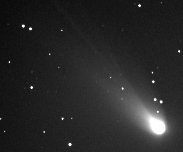<<PREVIOUS -
HOME -
CONTENTS -
NEXT>>
IMAGES -
![]()
<<PREVIOUS -
HOME -
CONTENTS -
NEXT>>
IMAGES -
![]()

Comets are icy bodies that orbit the Sun. They partially vaporize developing diffused tails of dust and gas when they get close to the Sun. Comets are usually composed of frozen water, carbon dioxide, methane and ammonia, in which dust and rocky material is embedded.
As a comet approaches the Sun, solar heating starts to vaporize the ices, releasing gas that forms a diffuse luminous sphere, called the coma around the comet nucleus.
Dust and gas leave the comet nucleus from jets on the side facing the Sun. Electronically charged ionized atoms are swept away directly by the solar wind magnetic field forming straight ion tails.
Small neutral dust particles get blown away from the comet by the Sunís radiation pressure creating broad and flat dust tails.
Tails grow as a comet approaches the Sun and are always directed away from the Sun. Therefore, the tail is towards the back of the comet when it is moving towards the Sun. The tail is towards the side of the comet when it moving parallel to the Sun and the tail is towards the front of the comet when it moving away from the Sun.
For example, the animation of Comet C/2000 WM1 (LINEAR) shows the comet tail in the direction of the cometís movement. These means the comet is moving away from the Sun.
The animation of Comet C/1999 S4 (LINEAR) shows the comet tail on side of the cometís movement. These means the comet is almost moving parallel with the Sun at it closest distance to the Sun in the cometís elliptical orbit.
Comets do not go zipping through the sky like meteors. They do noticeably move over short time spans of minutes to hours. Comet C/1999 S4 (LINEAR) showed movement in five minutes whereas comet Comet C/2000 WM1 (LINEAR) showed the same amout of movement in about a hour.